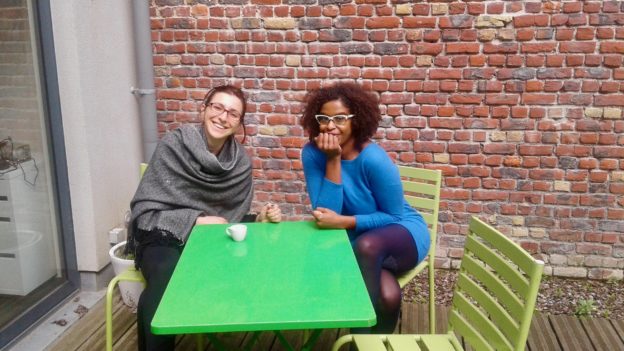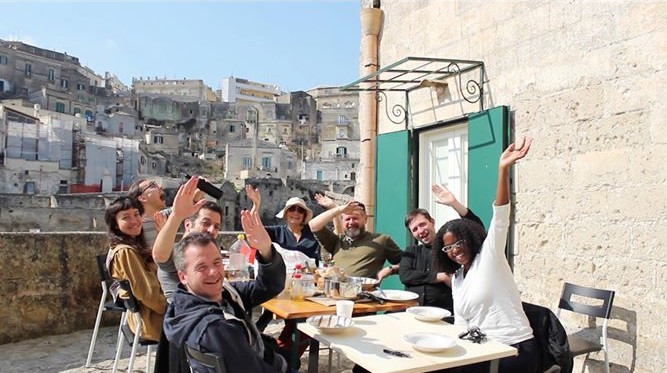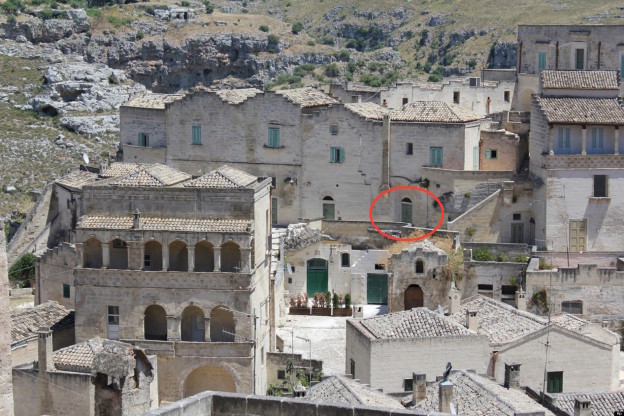A few months ago I gave a public talk on the unMonastery. I made the point that Saint Benedict can rightfully be considered a social innovator of titanic stature, and that modern-day open source hackers and activists could do worse than letting themselves inspire from monastic life in their quest to improve our world and live in harmony with it and each other. Someone showed a video recording of the talk to Nicola Alemanno, mayor of Nursia – the birthplace of Benedict himself. He was intrigued, and offered me and an unMonasterian delegation to meet with Father Cassian Folsom OSB, the superior of Saint Benedict’s monastery in town.
No way I was going to pass on the opportunity. The six-months unMonastery prototype in Matera has shown just how complex setting up and stewarding a healthy community is. Benedictine monks have been around for fifteen centuries, and have accumulated a lot of insight that it is not so accessible for us saeculars. So, Ben Vickers, Maria Byck and I traveled to Umbria, in the heart of Italy’s Appennines; accepted Father Cassian’s invitation to assist to the monks’ Mass (celebrated in Latin, and chanted – no spoken word at all, like this); and then sat with him and Nicola in an office in the city hall for a solid two hours.
We learned a lot. What was perhaps most interesting was exploring the common ground between monks and unMonasterians. This is neither as narrow nor as superficial as you might think.
Where we converge
Work is the forge of better, happier people
Benedictines hold work to be a good thing in and of itself. By doing work, monks can dedicate their lives to a superior ideal while remaining psychologically balanced. Progress in their work is both figuratively and literally progress in their faith; and the concrete nature of work helps monks keep their eyes on the ball. Notice that what’s good is not so much the result of doing work as its act. The ultimate purpose of work is to produce cheerful, peaceful, happy monks. So, it does not matter what the work actually does; what matters is how it is done.
Most hackers, activists and social innovators and unMonasterians take solace in their work too. Like monks, unMonasterians believe their work is important, but only very few think it will single-handedly “change the world”. Almost all projects within our reach are quite small. And yet, they feel important. Even the smallest and least influential open source project encodes a better world: the sharing of knowledge, generosity with one’s time, the attempt to make the world ever so slightly better and more free. Like monks, unMonasterians don’t do work because they think it is all-important and world-changing: they do it because they like to, because it makes them into the people they want to be.
Communities are the natural dimension of human life and work
Benedictine monks live together in semi-secluded communities. The reason for the detachment part is simple: they want to remove partially themselves from society at large, because society continuously bombards its members with stimuli that lead us away from God’s work. But why a community? In principle you could be a monk alone, an anchorite or hermit. But that turns out to be very hard, in fact impossible to most people (“Your thoughts become your enemy. You could go mad”, said gravely Father Cassian).
The solution offered by the Rule is, as so many things when Benedict is involved, peer-to-peer. Monks come together in communities, and each helps the other stay on track. Each monk is like a beacon for every other monk, broadcasting a continuous stream of information encoded in example: “this is the right path, you are on track”, or “here is how you could get even closer to our ultimate goal”. With appropriate seclusion, the monastic community can guide each individual monk along the commonly chosen path, drowning out the faulty signal of saecular society. Notice the architectural beauty of the solution: the community is not “a thing”. It is an emergent property of monks living together according to the rule, a well-structured ghost. And yet it works, as any monk will tell you.
unMonasterians share with monks a yearning to belong to a community that has different values and a different logic from those of society at large. In the calm of the unMonastery in Matera, overworked hackers and highly strung activists found themselves surrounded by like-minded people and felt like they could finally breathe. Suddenly no one was asking why would you not take a corporate job, or what’s so terribly wrong about proprietary software or data. Suddenly questioning fiat money or the right of government or corporations to implant backdoors on your computer or crunch your data through Big Data algorithms was normal. The ever-present risk of burnout seemed to subside; work acquired more clarity. The doors of the house were always open, and many people came to visit (no seclusion in that sense), but some unMonasterians did not like to leave the premises and tended to stay in a lot.
As an added benefit, living together in a community turns (some) drudgery into a source of pleasure. Just like in monasteries, at the unMonastery people took turns in cooking, washing up, and cleaning the space for the benefit of all. This turns out to be a great solution: when you are not on kitchen duty, life is good: you can move directly from your workspace to the dinner table, and a warm meal will be waiting. But when you are, life is also good: you have to set aside 2-3 hours (which is good, because it prevents you obsessing too much about work and burning out); typically you cook with another person, so you socialise and may even talk shop; and then you get an extra kick from giving your unBrethren a good meal. People will smile and thank you, and you will have made someone’s life better. Giving away some control over your day results in your day being better; having a non-negotiable commitment to accepting structure in your life helps people stay balanced. This discovery would be a lot more impressive if Benedict had not encoded it in his Rule fifteen centuries ago. D’oh, I guess – though Father Cassian, charitably, did not actually say it .
The Rule (or Protocol) as the basis of community life
Benedictine monasteries run on the Benedict’s Rule, which we interpret as a software protocol. The unMonastery has something performing the same function: we are calling it Protocol. We are not quite ready to write Protocol 1.0 yet: people are experimenting with simple rules (small R) you could write in few lines of code at a time (example: who does the work gts to make the related decisions). But we know it’s coming. By the way, I have a hunch you could design tests for candidate rules using methods from computational biology – a weekend project I’ll have to leave to less busy times.
Radicalize or die
Like all great open source projects, the Rule has been forked countless times. Even now the order is running different versions in different monasteries, and abbotts compare notes as to which variants produce which changes. The monastery in Nursia has elected to go back to the original version, and enforce it in a particularly strict way. Father Cassian thinks that the modernization of the Church’s ways introduced with the Second Vatican Council does not work well for the monastic movement. There seems to be a minimal threshold of radicalization below which a monastic community is simply not sustainable: societal pressure to conform overcomes the monks’ will. The Nursia community, with its long days (starting at 3.45 or 4.00 am), its rigorously chanted nine prayers a day, its fasting practices (one meal a day for a great part of the year, and never more than two), is prospering: the monks are “reasonably at peace”, and novices flock in.
The unMonastery has had no variants yet, and its sense of identity is frail at best. And yet, many of us would resonate with Father Cassian’s plan – certainly Ben, Maria and I did. The unMonastery can do social innovation, perhaps, but it should probably not get elbow deep into grant finance, or be saddled with too many deliverables. It should definitely not attempt to follow the flavour of the day (“smart city”, “startups”, “big data”, “scaling up”, and the dreaded “innovation”). It should probably take pride in its decentralist ideology, 200-years time horizon, geek culture and weird ways. No point being another vanilla co-working space. Certainly, the radical choice to look to monasticism rather than startup capitalism for inspiration has brought us in touch with unlikely, and interesting, travelling companions.
Engage in economic exchange (but don’t disrupt your hosts)
Benedictine monasteries have always engaged in economic exchange with their host local communities, and there are provisions for such activities in the Rule. It works like this:
- Monks must price a little lower than saeculars – doing otherwise would be avarice, a sin.
- Everything monks do must be high quality. It is work, and work is dedicated to God and leads to Him.
- Any profit you can make within these constraints is good, and you can use it to fund work that does not generate revenue.
Father Cassian is refreshingly unapologetic about the entrepreneurial activity of the monastery he leads. “We make a profit, and that is good.” The Nursia monks brew beer (do yourself a favour and check out their commercial and their blog) and run a gift shop. The beer is good. The gift shop refuses to sell cheap souvenirs, though it would be profitable.
Selling high quality stuff for below market price might not seem a promising business strategy, but historically monasteries have been economically successful. “We tend to get prosperous – shrugs Father Cassian – Because monks work hard.” And according to Nicola, the monks chose to brew beer because no one else in Norcia is making it. This means they are not in direct competition with anyone in the local community.
The unMonastery prototype was nowhere near as successful. But it did strive to engage the local community in Matera in a number of ways. Self-sufficiency remains a goal. And yet, the most obvious source of revenue for the unMonasterians in Matera – teaching English – was discarded in order to not disrupt the business of Materans who earn their living by doing just that.
Strive for self-sufficiency
No brainer. The Rule recommends for monks to eat what they grow with their own hands. It is not just a metaphor either: the monks in Nursia are building a farm. UnMonasterians have been looking out for scraps of land to turn into vegetable gardens and orchards; they try to upcycle and recycle and be as frugal as possible. The best path to sustainability is not revenue generation, but cost reduction.
Be a network
Benedictine monasteries are autonomous entities, but they do federate and coordinate into congregations. These supply certain important services: abbotts visit each other to check that the work being done stays on track (“you can think of it as quality control” ), and make themselves available to give counsel to their peers that are having a hard time and feel lonely. The unMonastery, too, was conceived to be a network of spaces; only the one in Matera has seen the light so far, but the founding group is trying hard to make it into many.
Where we don’t converge (yet?)
Underwriting the model: God vs. humanism
To monks, the lynchpin of this architecture is the belief in, and love of, God. All they do is to praise and serve Him. Monastic life may seem like a desirable model to us saeculars, but Father Cassian does not think we could achieve it and maintain it in the long run. Life in the monastery, the closeness to the community, the pleasure taken in doing good work contribute towards stabilizing the monk’s life and helping him stay his course; but that life is still hard, and requires iron discipline. Religion underwrites all that extra effort with heavenly rewards. Take them away and individuals will waver and fail the Rule; without the Rule, the whole community will come undone.
unMonasterians don’t enjoy this advantage. Individual unMonasterians can be religious, but that is no lynchpin to the community. The unMonastery has no metaphysical heat sink to absorb frustration, conflict, precarity. “If you have no God, what would you work for?” asked Father Cassian. Each other, maybe; or the pleasure of stewardship, of leaving Planet Earth a better place than you have found it. Father Cassian does not think those answer will be enough in the long run. Ben candidly acknowledged it: “Not having God is a problem”.
It’s not like unMonasterians have a choice. I doubt they can simply decide to believe in God. They will have to try, keeping their eyes on some higher goal that they think is worth dedicating their lives to, or simply go home. I think they will decide to try.
Long-term thinking vs. very long-term thinking
unMonasterians are proud of their long-term outlook on things (“we are building an institution for the next 200 years”). But Father Cassian and his brethren are standing on an intimidating 1500 years-long organizational memory. We simply cannot process the time scale at which monks think. Father Cassian regards the changes introduced in monastic life by the Second Vatican Council as an ongoing experiment, a sort of prototype, and going back to celebrating Mass in Latin in a mere 60 years is probably a Benedictine’s idea of failing fast. Should someone come up with 200 years of solid data suggesting that a simple move would be extremely beneficial to the Order, the Abbott Primate would probably say something like “Nice analysis, Brother, let’s give it another couple of centuries just to be sure it’s not a temporary fluctuation.” We are completely outmatched here!
Documentation vs. no documentation
This was a surprise: for all the open source logic of Benedict’s Rule and the whole Benedictine movement, monks appear not to keep documentation of what they do. When the Nursia crew decided to start their brewery, they simply dispatched Brother Francis to a monastery in Belgium that makes good beer, and told him to come back a master brewer. I am not saying a wiki would have been a good substitute for that, but I am saying that shared up-to-date online documentation would be a good resource for brethren trying to get the CO2 content or the fermentation speed just right.
After the meeting, Ben mused that monks would be perfect contributors to open source projects: patient, dedicated, generous. Teaching the use of wikis and issue trackers is one of the few areas in which unMonasterians could give something back to Benedictines.
What’s next?
The Rnext video has made an impact. Several people have independently shown it to nuns and monks around the country. We have received several invitations besides the one in Nursia. At least one oblate has visited the unMonastery – he, too, left with a standing invitation. The Nursia meeting has been enlightening. Could we build a relationship with the monastic movement? We clearly have much to learn from such a relationship. But why would the Benedictines talk to us? What do we have to teach in exchange?
For now, I am committing these words to this platform’s database together with our deepest gratitude to Father Cassian for taking time to answer our questions, and to Nicola for his wonderful hospitality. Monastery vs. UnMonastery felt a bit like going for a morning jog with Usain Bolt. We are not going to forget it any time soon.


